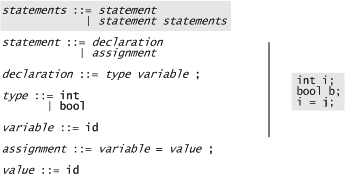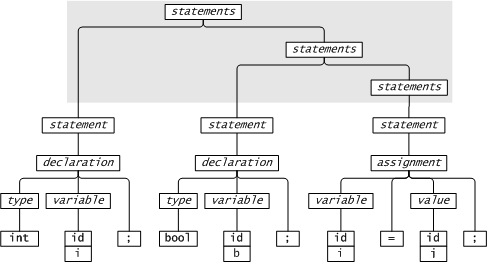Parse tree design
From CSSEMediaWiki
(Difference between revisions)
| Line 9: | Line 9: | ||
== Terminology == | == Terminology == | ||
In parsing lingo a ''symbol'' is a name in a grammar. Each symbol is either a ''terminal'' or a ''non-terminal''. Non-terminals appear on the left hand side of a grammar production; terminals don't. | In parsing lingo a ''symbol'' is a name in a grammar. Each symbol is either a ''terminal'' or a ''non-terminal''. Non-terminals appear on the left hand side of a grammar production; terminals don't. | ||
| + | |||
| + | == Class-Design == | ||
| + | |||
| + | [[Image:ParseTree.jpeg]] | ||
| + | |||
| + | That's the first Design that came up in class: | ||
| + | *the addKid()-function in the Terminal class throws an exception | ||
| + | *symbol is of type enum, which has a representation for every symbol of the grammar. | ||
Revision as of 05:39, 9 September 2008
A context free grammar defines a language, e.g.
A parse tree shows how a sentence in the language is structured according to the grammar.
Terminology
In parsing lingo a symbol is a name in a grammar. Each symbol is either a terminal or a non-terminal. Non-terminals appear on the left hand side of a grammar production; terminals don't.
Class-Design
That's the first Design that came up in class:
- the addKid()-function in the Terminal class throws an exception
- symbol is of type enum, which has a representation for every symbol of the grammar.


